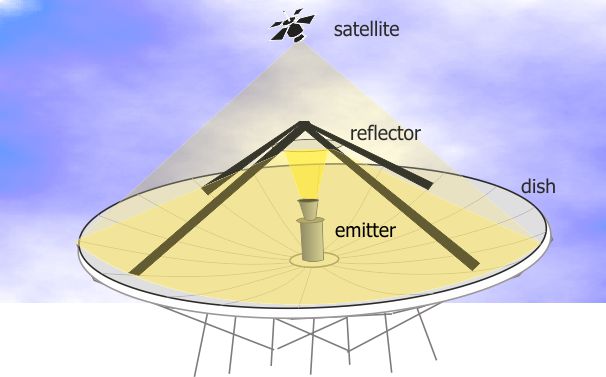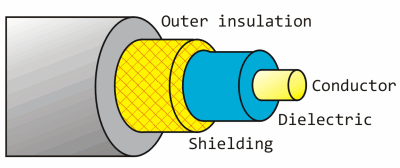Freesat reception - all about dishes
 Brian Butterworth published on UK Free TV
Brian Butterworth published on UK Free TV Satellite reception has both advantages and disadvantages compare with terrestrial (aerial) reception.
By using much higher frequencies (gigahertz, compared to terrestrial televisions megahertz) more transmission channels called transponders (the satellite equivalent of multiplexes) can be provided. For example, there are only six Freeview multiplexes, but Sky or Freesat users can access two hundred satellite transponders.
Aside from exceptional weather conditions (very heavy rain for example) digital satellite provides stable pictures and audio. Where Freeview transmitters are no more than 732 metres above sea level, the geostationary satellites used for television are 35,800,000 metres above the equator so reception is possible even where buildings, trees and hills make terrestrial reception impossible.

The downside of the transmitters being 22,300 miles up in the air is that the signals are very, very weak - so standard TV aerial is of little use. When the signals are sent to the satellites, huge dish transmitters are used to uplink the signal to the satellite. These are tens of metres from side to side, and feature an emitter that generates the signal, which is first bounced of a mirror (called a reflector) and then off the surface of the parabolic dish.

There are many satellites in the sky over the equator. Often these are in clusters over a particular position, for example there are four used for UK television are at 28.2 degrees east. There is another cluster over the 19.2 degrees east positions that are used for German television.
To receive these very weak signals from the satellite, it is necessary to use a dish for reception too. By using a reflective dish, this concentrates the signals onto a small device called a LNB. This is held in front of the dish by a metal arm.

The size of dish for reception is typically much smaller; often 60cm to 100cm in diameter, but the exact size depends upon the transmitting satellite transponder. To keep the transmission power levels down to levels that can be powered by the satellite's solar panels, each beam is focused on a particular area of the Earth's surface. If you are trying to receive the signal at the centre of this zone, a small dish is required. At the outer edges, you may need a 5 metre dish. Maps of these zones are provided by the satellite companies, and are called satellite footprints.
When the dish is installed it must be aligned carefully as the signal is very weak. The installer needs to know the inclination and the azimuth from the ground location to the satellite. If you install yourself you will find that there are markings on the dish that are used to point the dish in the correct position. It is important that the view of the satellite will not be blocked, so must take into account leaves growing on trees and potential building works.
For many people the LNB will have a single cable connected to it, however if you have Sky+ or a multi-room installation the LNB package will actually contain four receivers a quad-LNB. Unlike terrestrial television where you can split the aerial cable to feed more than one Freeview box or television set, with satelite reception you cannot. So, a Sky+ box with two receivers (so you can watch one thing and record another) has two cables connecting the box to the dish.
The cable that connects the dish to the receiver must be satellite grade cable. Whilst this looks superficially like the cable used to connect and aerial to a television, a higher grade cable is required for satellite reception.
Here is an image of a co-axial cable. This sort of cable is used to connect any type of receiving aerial to the reception equipment.

RG6, PF100 and PH100 are all types of coax cable that are suitable for the very weak signals that are received by a satellite dish. (The power is the same as you would receive from a one-bar electric heater on the moon).
The conductor in the centre passes the signals received from the dish to the set-top box. This is made from steel in RG6 cable, and from copper in the RF100 and PH100 types. This makes RG6 less suitable in the UK where rain can damage the cable.
The shielding is responsible for keeping unwanted external interference from damaging the signal. In the cheaper cable this will be a foil wrap, in better specified cables this is a braid (or mesh) of copper wires. The sheild in the RF100 covers 58% of the cable.
The non-conducting layer between the shield and the conductor is called the dielectric. This can be either a solid (RG6), foam (RF100) or air-spaced (PH100) dielectric. This makes the cables progressively more flexible (ie bendy without damage).
3:30 PM
Lochner,
I have a mobile home in Laroque des Alberes, departement 66, SW France. I had a 90cm satellite dish installed by Expert (French equivalent of Curry's)in le Boulou, but they have branches everywhere. I too have a Humax HD freesat digibox, and a Sony Bravia tv. I get brilliant reception of ALL the channels I get here in the UK, at no cost of course. Don't let anyone tell you different. I am currently investigating broadband internet via satellite dish. It's a bit pricey, but extremely feasible; see tooway.com website. Hope this helps.
| link to this comment |
Hi Brian,
I suspect that those who buy technomate & fortec star will use them for far more than just freesat, its probably more of a bonus feature, after all if freesat hd is all the user wants then a bush freesat hd is probably a better bet for mass market ease of use.
Mark Aberfan Aerials
| link to this comment |
Mark Aberfan Aerials: Yes, that is very true. I guess they can probably hang on the Freesat promotion as it is.
| link to this comment |
7:36 PM
Davyblue, Mark Aberfan Aerials & Briantist Maybe I need to look at updating the firmware again on my Passion and my Passion + but I've always found both sets of software to be very flaky. The Passion has 'Fortec Star' software & the Passion + 'Real' software but apart from different colours they are almost identical - even down to the mispelt 'Remainder' which I think should say 'Reminder' which appears on both as an option when setting a timer event. There is an option (on both) for a UK 7day EPG but I find when I use it, my favourite channels lists revert to the 'all channels' list, which with a couple of thousand channels stored makes navigation very difficult. As Mark says I don't use mine just for British channels but have a motorised dish & watch German, Czech & Polish channels too so my favourite lists are essential. Also I've never got the Passion + to work with a memory stick or external hard drive so I just use my Sony DVD recorder. I have to set each event on both machines seperately but it does work.
| link to this comment |
1:34 PM
Hi, I have freestat serving tv in lounge, can I use the same dish as an aerial to a second tv in my bedroom, the second tv I only need basic channels.
| link to this comment |
GOODWIN: Yes, you can connect any number of Freesat devices to the dish.
What matters is the number of "LNB outputs" that you have. If you only have a single output, you will need to change the LNB for a quad-LNB with four outputs.
You then just run in a satellite grade cable from the LNB output to each Freesat/Freesat HD box.
Satellite recorders require two connections, including Freesat+HD.
| link to this comment |
2:09 PM
Hi again, thanks for the info, I have a quad-lnb with 4 outputs, but when I wired tv to dish as an aeriel, tv message said ON SIGNAL as I said I only want basic channels to this tv what am I DOING WRONG?
| link to this comment |
GOODWIN: Are you sure you connected a FreeSAT box, and not a FreeVIEW box?
| link to this comment |
2:34 PM
hi yet agian, I don't seem to be having much luck. so could you just answer this question,can I CONNECT MY TV WITH A LEAD STRAIGHT FROM DISH TO TV. so I use the dish as an aerial hoping to recieve basic channels.THANK YOU.
| link to this comment |